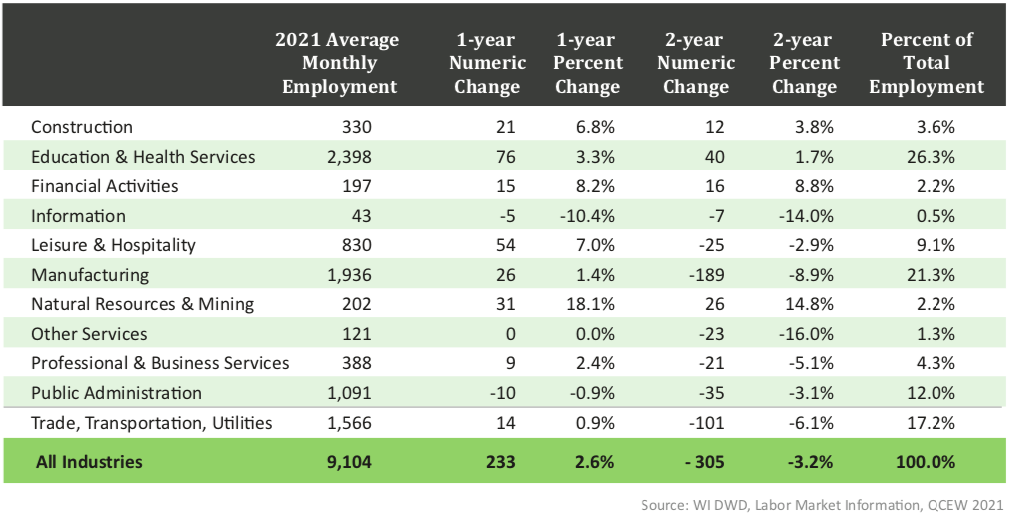Juneau County
Juneau County is the 27th least populated county among Wisconsin’s 72 counties. With an estimate of 26,848 residents in 2022, the county’s population has remained stable in the first two years of this decade. Since 2020, Juneau county gained 130 residents, equivalent to 0.5% of its population. In comparison, the state and nation experienced population growth during the same period, 0.9% and 0.3%, respectively. Of the county’s 10 most populous municipalities, the Town of Germantown gained the most residents (123), while the City of Mauston lost the most residents (-61).
Employment Change By Industry

From 2020 to 2021, employment in Juneau County increased by 233 jobs (2.6%) across all industries. This growth raised total employment to 9,104, 3.2% below the pre-pandemic level in 2019 (9,409). In comparison, Wisconsin’s total employment grew by 2.4% over the year. However, the state’s total employment was still 3.1% below its pre-pandemic level in 2019.
In Juneau County, the manufacturing industry experienced both the greatest numerical and proportional loss in employment in 2020 due to the pandemic. The industry saw a mild rebound in 2021, gaining 26 jobs over the year. Although the decline has stopped, fully recovery will take time. On the other hand, the strong growth in education and health service was encouraging. It is both the largest and fastest-growing industry in the county. The industry added 76 jobs over the year 2021, surpassing its 2019 employment level by 1.7%. Moreover, this industry made up 26.3% of total employment.
Transportation
Juneau County is a rural county. There is no local or intercity public transit system available in the county as of 2022. In fact, 38.1% of the residents travel outside of the county for work, and 37.1% of those that work in the county reside in another county. As expected, 88.5% of employed county residents rely on a car to get to work. More than three quarters drive alone, and the average commute time is 23.7 minutes. Car-centered infrastructure leads to a difficult conundrum: qualified individuals could fill a job if they had transportation and could afford transportation if they had a job. Some employers address this issue by offering telecommuting and transportation reimbursements.
Housing
Affordable and available housing that can fit different lifestyles and family needs are essential to attracting and retaining a productive workforce. Less time commuting lead to higher productivity and better mental health. However, as of December 2022, home prices have surged almost 40% since
2020, while mortgage rates have more than doubled since the start of the year. This has priced many buyers out of the market and slowed the construction of new homes, putting more stress on the rental market. High housing costs discourage job seekers from moving into the region, leading to a shortage of workers, especially for lower-wage roles.
Juneau County has a lower share of renters allocating more than 30% of income for housing compared to the state. Nonetheless, more than three out of 10 renters still pay more than 30% of their income on housing. In addition to cost, housing availability is also a challenge in Wisconsin. According to the National Low Income Housing Coalition, the state has a shortage of more than 120,000 rental units Owner-occupied housing is in short supply in many communities as well. Like the state, construction of new homes in the county had slowed down significantly after the housing bubble burst in 2008. A direct way to increase quality and affordable housing stock is to incentivize the creation of multi-family units, which requires loosening zoning regulation. Consolidating existing neighborhoods is also important. This includes providing more funds and loans for replacement housing and housing rehabilitation.
Child Care
Childcare cost in Juneau County is lower than the state average. Nonetheless, it is costly. The monthly cost of care ranges
from $690 for an infant to $481 for a school-age child. To put this cost in perspective, a household with median earnings in Juneau County would need to pay 14% of their earnings on infant care. Childcare availability is also a barrier to employment for Wisconsin families. According to the YoungStar provider database, there are 13 total providers with a potential capacity of 376 in Juneau County. This database tracks approximately 82% of providers in the state. The county has a lower capacity when compared to the state. There are nine childcare slots for every 100 children under the age of 14 in Juneau County compared to 14 statewide. Additionally, even families that have childcare struggle with disruptions. Easing the cost and access burden would help more parents enter or participate more fully in the labor market. Employers could also help improve participation by providing flexibility to parents with child care responsibilities.
